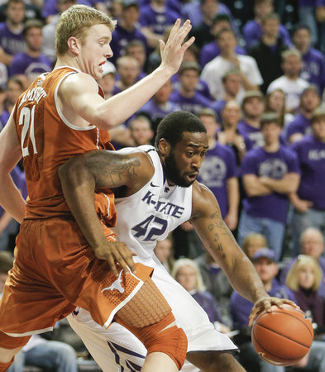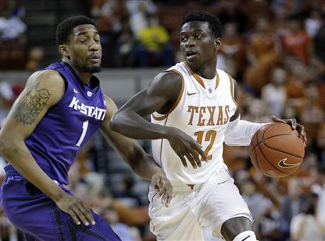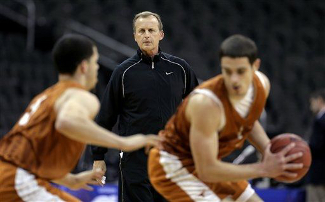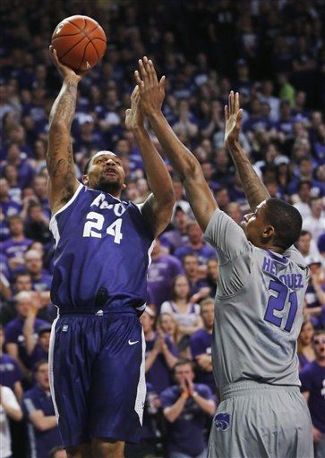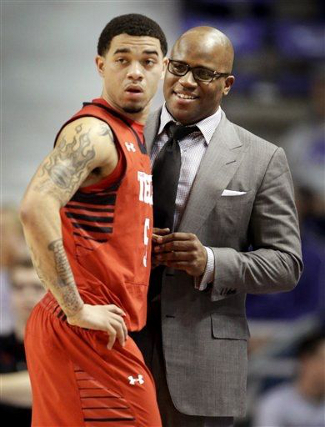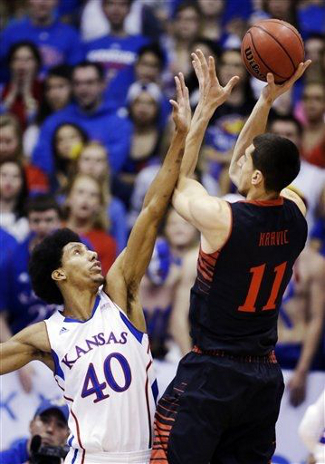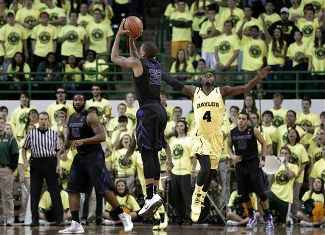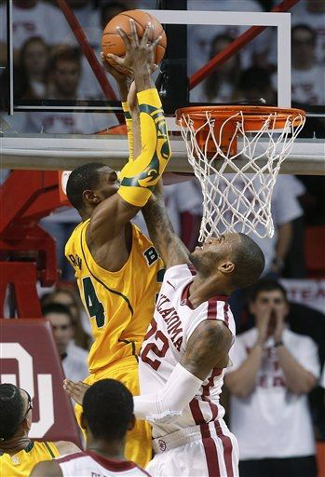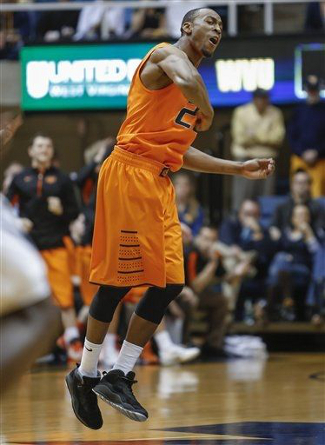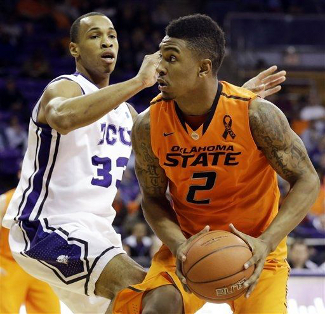Big 12 Championship Quarterfinals | Sprint Center | Kansas City, MO Tip: 6:00 P.M. CT | TV: Big 12 Network (Affiliate list) | Internet: ESPN3 LRT Consecutive Game #253 Last night, the Texas Longhorns took the first and easiest step in their pursuit of an improbable Big 12 title, dispatching No. 10 seed TCU, 70-57. Texas must win the conference tournament to avoid missing the NCAA tournament for the first time in 15 years, which means that the young Horns have to put together four wins in four days. With the first victory under their belt, things now get much tougher for Rick Barnes’ inconsistent bunch. Awaiting the Horns in the quarterfinals are the experienced Kansas State Wildcats, who beat the Horns by a combined 38 points in the team’s two meetings earlier this year. It has long been said that it’s tough to beat the same team three times in a season, but those prior results offer Texas fans little reason for optimism about tonight’s match-up. Even in the relatively-close 12-point loss to Kansas State in Austin, Texas was out of the game for the entire second half, and trailed by as many as 19 points. Ken Pomeroy gives the Horns a 27% chance to win, predicting a six-point margin of victory for the ‘Cats. The Longhorns will have to overcome those odds and what will amount to a home crowd for KSU if they want to keep their NCAA dreams alive. Meet the Wildcats For an in-depth look at the Kansas State roster and the team’s style of play, check out LRT’s game preview from the first meeting between these two teams.
Texas could not slow down Thomas Gipson in Manhattan The first match-up When Texas and Kansas State first faced off on January 30th, the game was quickly out of reach. The Longhorns had two leads in the first four minutes, but trailed 9-7 at the under-16 media timeout. Texas would never get any closer, falling victim to a brutal stretch of offensive inefficiency. For a span of more than 12 minutes in the first half, Texas managed only eight points, with all of them coming from Sheldon McClellan. The Longhorns did manage to get some good looks early in the game, but could not make any buckets. With shots not falling, Texas only made things worse by constantly turning it over and giving up easy points to the Wildcats. On the night, Texas ended 27.5% of their possessions with a turnover and allowed KSU to score 33 points off of those miscues. In a lopsided 83-57 loss, those wasted possessions and free points were easily the difference in the game. Most troubling for Texas fans is that this beatdown came with Rodney McGruder limited due to foul trouble and Will Spradling (No. 55) playing with a broken nose he suffered in the first half. With those two only chipping in 12 points, it was Texas-born big man Thomas Gipson (No. 42) who dominated the game, scoring 17 points and grabbing seven boards in only 21 minutes on the court. The rematch Even with Myck Kabongo back in the lineup, things did not get much better for Texas when they hosted Kansas State on February 23rd. The Longhorns failed to challenge the Kansas State shooters all afternoon, allowing the Wildcats to knock down 50% of their 18 three-point attempts. Texas still managed to find itself down just three points late in the first half, but a disastrous exchange shoved the momentum to the Kansas State sideline before the teams headed to the locker room. With 22 seconds left, it appeared the Wildcats would hold for the last shot. Instead, Javan Felix fouled Angel Rodriguez (No. 13), who knocked down a pair of free throws. Kabongo then turned it over with just two seconds left in the half, and the Wildcats raced down the court for a three from Shane Southwell (No. 1) just before the horn. Things continued to deteriorate in the second half. The Longhorns took more than four minutes to score a basket, allowing Kansas State to extend its lead out to fifteen points. Texas never recovered, trailing by as many as 19 points midway through the half. The Horns closed the gap for cosmetic purposes, but still dropped the final decision at home, 81-69. Kabongo led the way for Texas, scoring what was then his career high of 24 points. McClellan came off the bench to score 15 points, rebounding quickly from his benching in the TCU game just five days earlier. Both players were able to score in transition and Kabongo drove to the rack in half-court sets, but otherwise the offense was bogged down. The Longhorns also again struggled to keep Kansas State from reclaiming missed shots. The Wildcats snagged 41.4% of their offensive rebounding opportunities in Austin, improving upon the impressive 40% mark they had posted in Manhattan. Those extra chances only resulted in seven second-chance points for K-State, but they demoralized the Longhorn defense when it did manage to force a missed shot. Keys to the game 1) Look for transition opportunities – In both games against Kansas State, the Texas offense had a very difficult time scoring in their half-court sets, but did find some success on the break in Austin. Unfortunately, the Wildcats take good care of the ball, turning it over on only 18.4% of their possessions. That means that transition opportunities for Texas will have to come off of missed K-State shots. Of course, the Horns have had difficulties winning defensive rebounds against the Wildcats, so this could be a very tall order. 2) Communicate and rotate on defense – Kansas State’s offense can look like a well-oiled machine when it is clicking, as the Longhorns discovered when the ‘Cats sliced them up with crisp ball movement in Austin. In addition, Rodriguez has the ability to slash through defenses and pull defenders away from the K-State bigs inside and the shooters waiting on the perimeter. The Longhorns must play sound team defense, communicate, and rotate quickly if they hope to disrupt a Kansas State offense that scored 1.26 points per possession against them in their two earlier meetings.
Texas needs another strong showing from Kabongo 3) Aggression from the guards and wings – Texas found success in the second half of last night’s game when Kabongo, McClellan, and Julien Lewis started attacking with the bounce and making harder cuts off the ball. As a result, the Horns posted a free-throw rate of 82% against TCU, meaning that they shot more than eight free throws for every ten field goal attempts. Coming on the heels of a 62.7% free-throw rate against Texas Tech, it appears that the normally-stagnant Texas offense is finally making an effort to grind out points at the line. Combine this recent trend with Kansas State’s penchant for sending opponents to the stripe, and the Longhorns may be able to pile up some points. Even if Texas does not end up drawing many fouls by attacking with the bounce, any sort of aggression will be an improvement. Static possessions with excessive perimeter passing and challenged looks late in the shot clock have unfortunately been the norm for Texas for much of the season. If the ballhandlers can be aggressive, while Lewis and McClellan work hard to get open off the ball, Texas can stay competitive this evening. If not, the Horns will likely be victims of a third K-State beatdown this year. |








